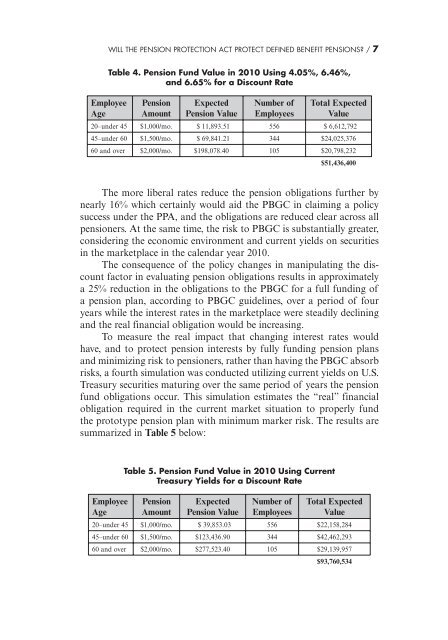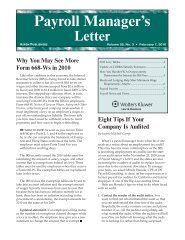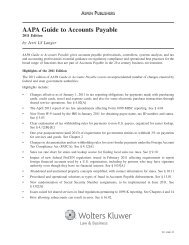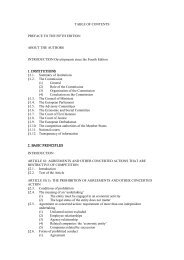journal of pension planning & compliance - Kluwer Law International
journal of pension planning & compliance - Kluwer Law International
journal of pension planning & compliance - Kluwer Law International
Create successful ePaper yourself
Turn your PDF publications into a flip-book with our unique Google optimized e-Paper software.
WILL THE PENSION PROTECTION ACT PROTECT DEFINED BENEFIT PENSIONS? / 7<br />
Employee<br />
Age<br />
Table 4. Pension Fund Value in 2010 Using 4.05%, 6.46%,<br />
and 6.65% for a Discount Rate<br />
Pension<br />
Amount<br />
Expected<br />
Pension Value<br />
Number <strong>of</strong><br />
Employees<br />
Total Expected<br />
Value<br />
20–under 45 $1,000/mo. $ 11,893.51 556 $ 6,612,792<br />
45–under 60 $1,500/mo. $ 69,841.21 344 $24,025,376<br />
60 and over $2,000/mo. $198,078.40 105 $20,798,232<br />
$51,436,400<br />
The more liberal rates reduce the <strong>pension</strong> obligations further by<br />
nearly 16% which certainly would aid the PBGC in claiming a policy<br />
success under the PPA, and the obligations are reduced clear across all<br />
<strong>pension</strong>ers. At the same time, the risk to PBGC is substantially greater,<br />
considering the economic environment and current yields on securities<br />
in the marketplace in the calendar year 2010.<br />
The consequence <strong>of</strong> the policy changes in manipulating the discount<br />
factor in evaluating <strong>pension</strong> obligations results in approximately<br />
a 25% reduction in the obligations to the PBGC for a full funding <strong>of</strong><br />
a <strong>pension</strong> plan, according to PBGC guidelines, over a period <strong>of</strong> four<br />
years while the interest rates in the marketplace were steadily declining<br />
and the real financial obligation would be increasing.<br />
To measure the real impact that changing interest rates would<br />
have, and to protect <strong>pension</strong> interests by fully funding <strong>pension</strong> plans<br />
and minimizing risk to <strong>pension</strong>ers, rather than having the PBGC absorb<br />
risks, a fourth simulation was conducted utilizing current yields on U.S.<br />
Treasury securities maturing over the same period <strong>of</strong> years the <strong>pension</strong><br />
fund obligations occur. This simulation estimates the “real” financial<br />
obligation required in the current market situation to properly fund<br />
the prototype <strong>pension</strong> plan with minimum marker risk. The results are<br />
summarized in Table 5 below:<br />
Employee<br />
Age<br />
Table 5. Pension Fund Value in 2010 Using Current<br />
Treasury Yields for a Discount Rate<br />
Pension<br />
Amount<br />
Expected<br />
Pension Value<br />
Number <strong>of</strong><br />
Employees<br />
Total Expected<br />
Value<br />
20–under 45 $1,000/mo. $ 39,853.03 556 $22,158,284<br />
45–under 60 $1,500/mo. $123,436.90 344 $42,462,293<br />
60 and over $2,000/mo. $277,523.40 105 $29,139,957<br />
$93,760,534






